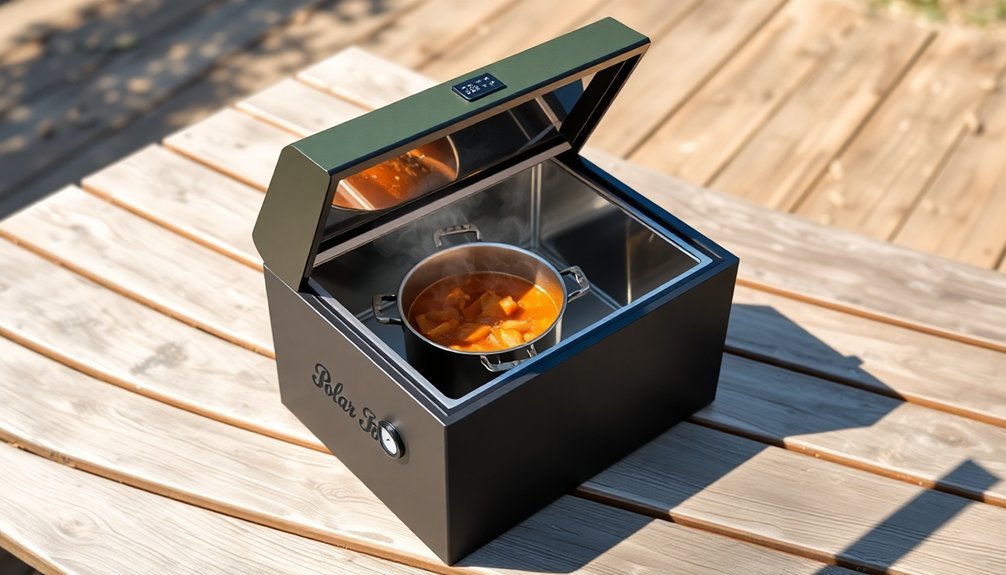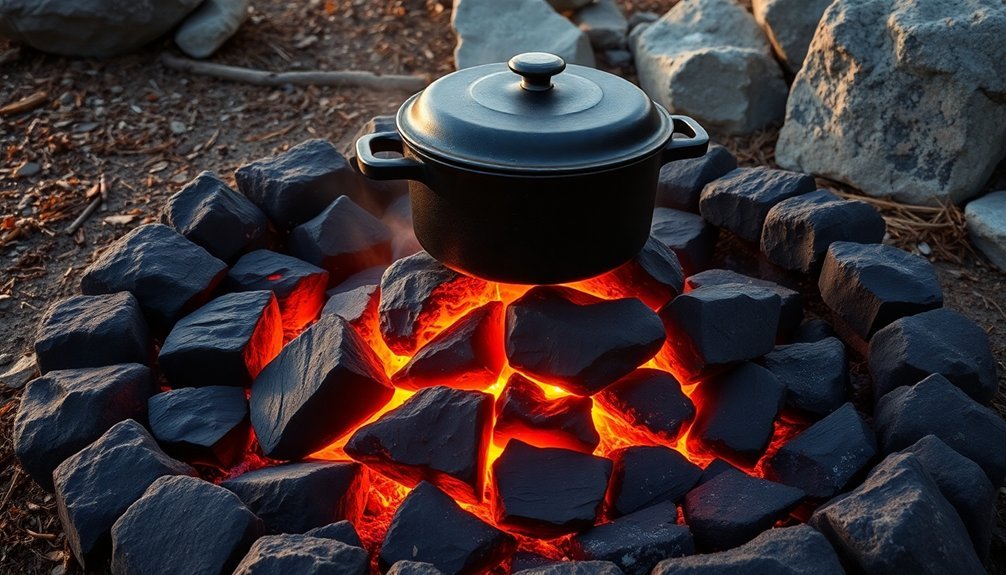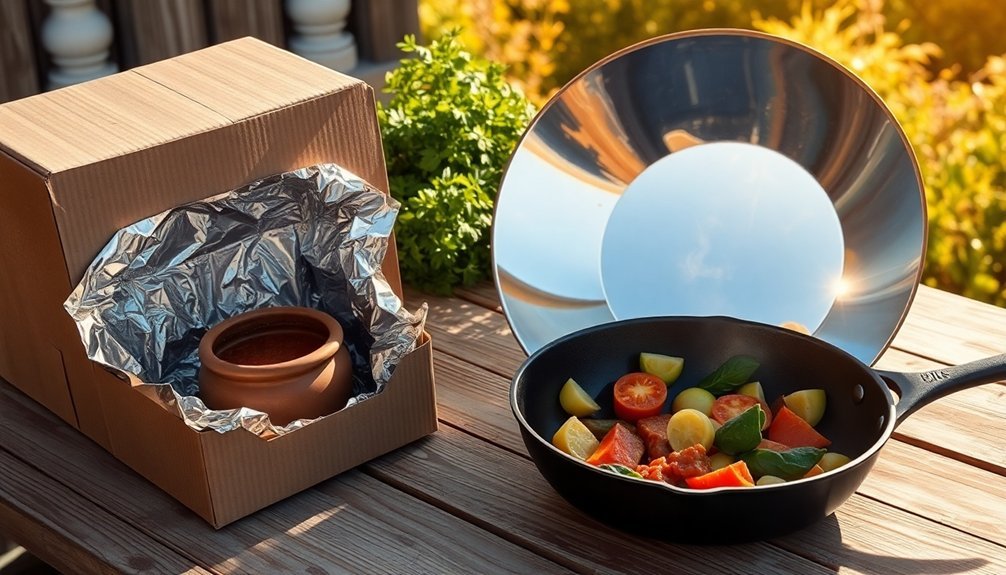You'll find several eco-friendly ways to cook outdoors without traditional fuel sources. Solar box ovens harness sunlight to reach temperatures up to 300°F, while earth ground ovens use thermal mass to maintain heat for hours. Sun-dried food preparation offers a simple preservation method that intensifies flavors naturally. Hay box thermal cooking lets you conserve energy while slow-cooking hearty meals, and stone heat retention methods tap into one of humanity's oldest cooking techniques. These time-tested approaches not only reduce your environmental impact but also connect you to sustainable culinary traditions that have sustained communities for generations.
Solar Box Ovens

While conventional cooking methods rely on electricity or fuel, solar box ovens harness the sun's energy to create an efficient, eco-friendly cooking solution.
You'll find these ovens work best between 11:00 am and 3:00 pm, when sunlight is most intense.
The design's genius lies in its simple components: a dark-colored cooking chamber with a clear window, reflective surfaces to direct sunlight, and insulation to trap heat. Similar to how Solar Direct installations maximize efficiency, proper positioning is crucial for optimal performance.
You'll need to position your oven facing the sun and adjust it regularly for peak performance.
Inside temperatures typically reach 200°F to 300°F.
Though cooking takes longer than traditional methods, you can prepare various dishes from stews to baked goods.
It's perfect for emergency situations, summer cooking without heating your house, and even water pasteurization.
Just remember to keep those reflective surfaces clean for maximum efficiency.
Earth Ground Ovens
Another ancient yet effective fuel-efficient cooking method comes from the earth itself. You can build an earth ground oven using readily available materials like clay, sand, straw, and firebricks. The bell-shaped design, featuring a thick thermal layer and insulation, allows these ovens to maintain cooking temperatures for over six hours while using minimal wood. These traditional ovens have remained essentially unchanged for thousands of years due to their proven effectiveness.
Creating your earth oven requires:
- A solid foundation of urbanite or stone for stability
- A dome structure built with wedge-shaped rocks
- A mixture of cob (clay, sand, and straw) for thermal mass
- A wooden door to seal in heat
You'll find these ovens incredibly versatile, perfect for baking bread, pizzas, casseroles, and vegetables.
Best of all, they're sustainable, using local materials and requiring only small amounts of deadfall branches for fuel.
Sun-Dried Food Preparation

Sun-dried food preparation stands as one of humanity's oldest preservation methods, requiring nothing more than nature's elements to create delicious, shelf-stable ingredients. You'll need temperatures above 85°F, low humidity, and steady airflow to successfully dry your foods. Start by selecting fresh, ripe produce and cutting it into uniform, thin slices under half an inch thick. Proper pre-treatment of fruits with lemon juice dipping helps prevent oxidation and maintain quality.
| Food Type | Drying Time | Preparation | Best Uses |
|---|---|---|---|
| Fruits | 2-4 days | Slice thinly | Snacks, baking |
| Vegetables | 3-5 days | Blanch first | Cooking, sauces |
| Herbs | 1-2 days | Whole leaves | Seasoning |
| Mushrooms | 2-3 days | Slice evenly | Soups, stews |
Once dried, your foods will retain 15-20% moisture content, preserving nutrients while intensifying flavors. You can rehydrate them later for cooking or enjoy them as nutritious snacks.
Hay Box Thermal Cooking
Thermal cooking with a hay box offers a clever way to conserve fuel while preparing hearty meals outdoors.
You'll need to bring your food to a boil first, then place the lidded pot in an insulated container filled with materials like hay, shredded newspaper, or cotton balls. This century-old method works particularly well for soups, stews, and grain dishes. This technique gained widespread use during World War II rationing when fuel conservation was crucial.
- Fill your pot completely to maximize heat retention
- Choose a well-insulated container, from wooden boxes to modern coolers
- Bring ingredients to a full boil before transferring to the hay box
- Monitor cooking time to guarantee food safety
You can enhance your hay box's efficiency by adding emergency blanket material or using modern alternatives like Wonderbags.
If you're concerned about food safety, simply bring the dish back to a boil before serving.
Stone Heat Retention Methods

Cooking with heated stones represents one of humanity's oldest and most versatile fuel-free methods.
You'll need to select granite or similar dense rocks from dry locations, avoiding slate and shale which can explode when heated.
Before cooking, clean your chosen rocks thoroughly with warm soapy water and season them with oil if you're using granite.
Heat them gradually for 30-45 minutes to prevent cracking.
You can employ several techniques: drop hot stones into containers for boiling soups, use flat rocks as griddles for frying, or cook directly on heated stones for steak and seafood.
The beauty of stone cooking lies in its versatility and efficiency.
Your stones will retain heat exceptionally well, allowing you to cook without ongoing fuel needs while achieving excellent searing results on your food.
Frequently Asked Questions
Can Fuel-Free Cooking Methods Work Effectively During Winter Months?
Yes, you'll find fuel-free cooking works in winter using fireless cookers, upside-down fires, and preheated stones. However, you'll need proper insulation to maintain heat, and solar methods may be less effective on cloudy days.
How Long Can Cooked Food Stay Safe in Outdoor Cooking Devices?
You shouldn't leave cooked food out for more than two hours, or one hour if it's above 90°F. Make sure you're monitoring temperatures and using insulated containers to keep hot foods above 140°F.
Which Foods Should Never Be Prepared Using Outdoor Fuel-Free Cooking Methods?
You shouldn't prepare raw meats, poultry, fish, eggs, or dairy products using fuel-free methods. These foods require precise temperature control and quick cooking times to remain safe for consumption and maintain proper texture.
Are There Specific Materials That Could Be Toxic in Fuel-Free Cooking?
You'll need to avoid Teflon, PTFE, aluminum, and chemically treated bamboo as they can release toxic substances when heated. Don't use plastics or synthetic materials that might melt or contaminate your food.
What Backup Options Exist When Weather Conditions Suddenly Change During Cooking?
If weather changes mid-cooking, you'll want to move food to a hay box cooker or portable propane stove. You can also switch to indoor tea light ovens or candle cookers as safe alternatives.
In Summary
You'll find these five fuel-free outdoor cooking methods give you reliable ways to prepare meals without depending on electricity or gas. Whether you're using the sun's power, earth's natural insulation, or heat-retaining materials, these techniques help you cook sustainably while connecting with traditional practices. Try them out during your next outdoor adventure – you'll discover they're practical, eco-friendly alternatives to conventional cooking methods.





Leave a Reply